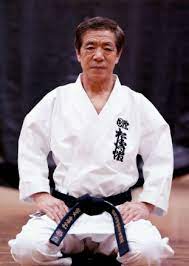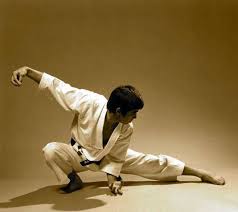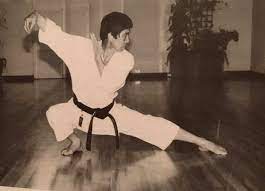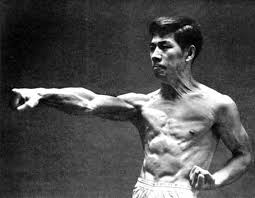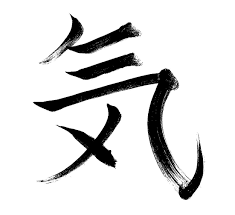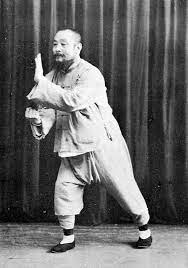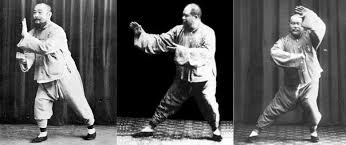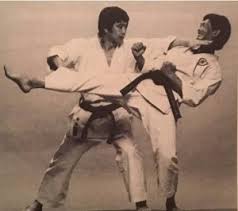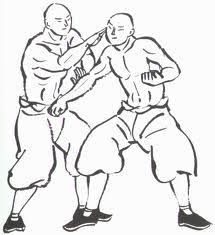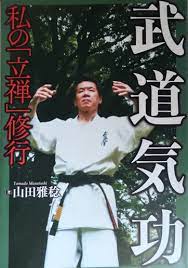Tai Chi and Karate seem to be antagonistic at the first glimpse. However, Hirokazu Kanazawa has shown that both arts are just one side of the same coin. In his Article, Prof. Dr. Wolfgang Herbert illuminates the relationship of Tai Chi (Taijiquan) and Karate. He will make extensive use of his knowledge as a Tai Chi practicioner and student of Hirokazu Kanazawa. In this article, I will reflect upon the connections between Karate and Tai Chi[1]. These deliberations are based on my personal experience and thus inevitably limited in scope Although I dabble(d) in other styles, I primarily practice Shôtôkan Karate and Yang-style Taijiquan. Both of the syles have their pecularities and characteristics, which set them apart from other
styles of their family, i.e. Taijiquan and Karate. Shôtôkan with its long, mostly linear moves, deep stances and strong (momentary muscular) focus (kime) is on the “hard” side in Karate. Yang-style Taijiquan is the most relaxed, slowest and softest way to practice Taijiquan. These two styles therefore make a perfect contrast. I began my Taijiquan training under Kanazawa Hirokazu[2] (1931-2019) in the 1980s. Kanazawa-sôke studied Yang-style Taijiquan under Yang Ming-Shi (jap. Yô Meiji 楊名時 1924-2005) and was a dedicated lifelong adept of this art. Therefore, I will frequently quote and refer to Kanazawa-sôke and his experiences. He has shaped my understanding of Karate-dô like no other teacher and without him I might never have practiced Taijiquan. When I saw Kanazawa-sôke’s Karate for the first time I was struck with awe. His movements had a smooth fluidity and naturalness, yet tremendous power. His techniques exploded like a thunderbolt, in between was tranquillity. Although I had for many years been under the direct supervision of two wonderful Japanese Sensei (Sugimura Kôichi [1940-2020] and Fujinaga
Yasuyuki [1944-1995], both JKA), who had an elegant and swift Karate of their own, Kanazawa-sôke s Karate had a completely different quality. It came from a higher dimension. With hindsight I can say that this was undoubtedly due to his immersion into Taijiquan and its respective philosophical underpinning
Kanazawa-sôke and his encounter with Taijiquan
Tai Chi and Karate – Yin and Yang Let us first listen to Kanazawa-sôke about his involvement into Taijiquan. In his autobiography he writes about the arduousness of learning Taijiquan: “If I hadn’t already spent so long trying to master karate, I suppose it wouldn’t have been so difficult, but I was constantly being told ‘don’t use your strength. Don’t do it quickly. Don’t focus it so much. Don’t use your muscles …’ Everything I was supposed to do seemed at complete odds with karate. It put me in a real bind. Before long, however, I began to get used to the movement. I realised that being able to ‘not use my strength’ meant that I would be able to use it if I needed to. Doing things slowly meant that I would be able to do it quickly if so required And, being able to not make each technique decisive, meant that I could focus if necessary.” (Kanazawa 2003:224-5)
In an interview with Mike Clarke in 1995 Kanazawa spoke extensively about his acquaintance with Taijiquan. He started training Taijiquan at the beginning of the 1960s under Yang Ming-Shi, with whom he devoloped a deep and lasting friendship. Yang was at the time learning Karate at the JKA. Kanazawa found it very hard to come to terms with the way one moves in Taijiquan. After one year he even thought of giving it up. He remarks that it took him two years to get an inkling or feeling for its essential qualities. Here are some excerpts from the interview:
Tai Chi and Karate – Yin and Yang
“It has effected (! affected?) my karate by being completely different. … But they balance each other.
They give me a different view of the same thing. I can see things clearer about karate when I am doing Tai Chi. Before I only had the karate view of things and so I could not see things by myself. I was training hard and so did not have the time or space to see my karate, but now with Tai Chi I can see my karate.
You see if I do just karate then maybe I will reach a level and just stop. This could be because of the way it teaches me to use my body. It is good at giving understanding of how to use energy. You see Tai Chi is not about focus, always it is flowing like water. This means that at any time you can be strong at any place.” On Karate and Taijiquan: “I think they are better if looked at seperately. It is like a wife and a husband. They are different. One is a man the other a woman. They have differences in many things, but when they are together they harmonise and this is better than either on their own because now they are family. It is the same with karate and Tai Chi, they should not be mixed, but they can be studied
together and the idea harmonised. This is the way I think of Tai Chi and karate.
You see if you have karate over here, hard, fast, strong. And then you have Tai Chi on this side, soft, slow, relaxed. Now if you train in either one and continue for a long time, in the end you will end up in the same place. But you will not get to this place if you mix them together … in Tai Chi you learn about Chi in the beginning and try to get the feeling, that is the intention. But in karate it is not like that, you do not go into karate training thinking about Ki energy. I am speaking here only personally, some Masters of karate may instruct their students in Ki at the start, but I don’t know any that do.”
Kanazawa-sôke and his instructions concerning Ki
As the title suggests, Kanazawa-sôke in a very personal book, speaks at length about his encounter with Taijiquan, the gist of it corresponds with the contents of the interview with Mike Clarke. He then muses about his understanding of Karate. Let me cite some passages. Every word could also be said about Taijiquan, which only shows how deeply the two amalgated in Kanazawa’s view of martial arts:
“… I know that my Karate makes me deeply happy. If good movement is equal to natural movement, then good movement is part of nature and produces a unity with nature. Regular training with concentration will produce strength even if the movements in themselves are imperfect. It is, therefore, more important to concentrate than to try deliberately to produce strength. … It is important that people understand the vital lines and points of the body. … the points and meridians are connected with blood circulation, they are also strongly connected with the circulation of spirit energy, or Ki. This corresponds to the Chinese ‘chi’. The organs of the body are also affected by the movement of spirit energy … Karate must be good for character building and making the spirit strong. Karate is a philosophy but if the student wishes to
understand the philosophy he must train in simple movements. … For example when executing a stepping punch, the head should be pushed upwards. This is in accordance with universal mechanics with the action producing a reaction. If at the same time breath is exhaled then there is a mental and physical reaction. Strength is produced at a point in the abdomen known as hara. This is the focal point for spirit energy … for true balance the control must be through hara. This balance is positive and negative and mind and body are one. Balance of the body by hara produces balance of the mind. For twenty-five years I have not felt anger nor a desire to fight. This is Karate.” In the introduction to his first Kata-book, Kanazawa-sôke writes again with reference to Ki: “The Shodoka (calligrapher) creates art form on white paper with sumi (black ink), likewise the Budoka (exponent of the way of martial arts) expresses his
personality with his techniques. When performing a Kata, to remain calm and with a clear mind, we must always concentrate and maintain our ‘Ki’ until the last movement. We should co-ordinate the mind and power in each movement with proper breathing.” (Kanazawa 1981:15) My struggle with Taijiquan
My struggle with Taijiquan
I can vividly remember how Kanazawa-sôke told us to imagine we are forming and holding a “ball of Ki” in our hands in movements where the palms of the hands are held apart, but vertically facing each other (e.g. the opening moves in “part the wild horse’s mane” or “grasp sparrow’s tail”). You had a tingling sensation, almost like a subtle electrical current. It felt “real”. Sôke also told us when doing Karate punches that the tsuki did not end at the fist, but goes way beyond, because the Ki shoots out far on and yonder.
At the time, when I began to learn Taijiquan I was in my twenties and an athlete and sports competitor. I liked “hard” conditioning like muscle training (with and without weights), punching and kicking the sandbag and makiwara and running. To be honest, I found Taijiquan a tad tedious at the time. There were no “obvious” physical results and it was just too slow. However it was aesthetically pleasing, graceful, meditative, poetry in motion. And it was challenging. I had the same problems Sôke described when he started with Taijiquan. It was extremely difficult to not use any force and totally relax. I did not pursue my Taijiquan practice until a few years ago. I remembered that Sôke always advised us to concentrate on inner energy rather than muscular power when getting older and to practice Taijiquan.
I joined a group affiliated to the Japan Wushu Taijiquan Federation (JWTF, jap. Nihon Bujutsu Taikyokuken Renmei). Now I receive regular instruction and exercise Taijiquan on a daily basis. I related that to Sôke at a time when he was already in his eighties. He was overjoyed: “Taijiquan and Karate are like Yin and Yang, soft and hard, fluid and rapid, circular and straight! They are complementary and synergetic. It is good to practice both. Especially when one grows old it is commendable to Kanazawa & Adamou 1981: 17-8move to the softer side. It is not about muscular strength anymore, but the cultivation of the Ki that should become central. Carry on!” The same problems persisted though: I was consistently told to relax more, let it flow, forget any tension. Paradoxically it was strenuous just to totally loosen up. It seemed that I just could not get the “feel” fo Taijiquan.
I am a scholar by profession and like to read and study. I need an intellectual grasp and a rational understanding of things in order to accept them. But Karate has taught me: martial arts can only be “understood” by one thing: practice, practice, practice. They have to be literally “incorporated”, programmed into your body (lat. corpus), engrammed into your neuro- physiological system. Thus I kept exercising, enjoyed the beauty of the movements and the calmness of mind they engendered. I gave up to look for “results”. The benefits revealed themselves incrementally through continuous exercise and the embodiment of the art. I discovered some common principles shared by Tai Chi and Karate.
To name the most important ones:
The waist (seika tanden/hara) as fulcrum, center of power, Ki-repository
The chain of energy transfer from heel to hand the use of three axis: center line, the right and left axis connecting the shoulder/armpit with the hip joint
The alignment of the knee with the toes
Rooting and balancing of stances
Diaphragmatic breathing, also called abdominal or belly breathing
Straightening the backbone, upright posture
The connection between upper (trunk/torso) and lower body (hips/thighs)
Every motion is a full-body movement
Unification of body and mind
Body awareness and mindfulness
Taijiquan fosters acute self-awareness. One learns to scan bodily sensations and the whole inner somatic landscape. One is fully conscious of every movement and the body parts involved in it. This kinesthetic sense is heightened by Taijiquan and this faculty can be transferred into the way one does Karate. Through the slow motion and inward orientation in Taijiquan, all the above entioned principles are constantly checked, mindfully observed and absorbed. One of the ffects is, that you start to practice Karate with the same introspective mind and sharpened body consciousness.
The utter loosening up you learn in Tai Chi gives you a new understanding for the calibration and especially the release of tension in Karate. You will get rid of any tightness. Techniques will be taut (not rigid!) when focused (kime) for an instant only and then implode into total relaxation. Your Karate will become lighter, quicker, fluent yet firmly grounded.Kanazawa Hirokazu practicing Taijiquan in
Ten common principles of Tai Chi
I want to go into some more detail in regard to principles in Taijiquan (distilled from the manuals of the JWTF/ Ishihara a.o. 1991 & Nagasawa a.o. 1993). They can readily be applied to Karate. Keeping them in mind can enrich and improve your performance
(the numbers do not reflect a prioritization, all principles are of equal importance):
1. 一動全動 ichidô zendô: When one part of the body moves, the whole body moves.
2. 立身中正 risshin chûsei: The spine is straightened, standing totally upright. This is connected with the following:
3. 尾閭中正 biryô chûsei: the coccyx (tailbone) is tucked in, thus the S-curve of the spine is flattened. Qi/Ki will then flow more smoothly and unimpeded.
4. 虚領頂勁 kyoryô chôkei: the head is held upright, the neck relaxed, no strength should be used, it should feel as if the crown were suspended from above. “The Tai Chi classics say: ‘The spine should be like a necklace of pearls hanging from heaven.’ This highlights how Tai Chi can improve the vertical stance by elongating the spine, including the neck … .” (Wayne 2013:139)
5. 内外相合 naigai sôgô: the inner and the outer are in harmony, i.e. intention, movement and breathing are one. Yang Deng Fu (1883-1936) calls it “internal and external unity” and: “The training of Tai Chi Chuan is in the mind; thus ‘the mind is the commander, the body is the agent’. When the mind is trained, movements and actions become naturally light and agile.” (in: Wong 2002:37)
6. 上下相随 jôge sôzui: the hips are the axis and centre of control and connect the upper and lower part of the body and drive the movements of the limbs. For this coordination of bottom and top in a movement, the formula in the Tai Chi classics reads: “Its root is in the feet, executed from the legs, controlled by the waist, materialized in the hands and fingers.” (Wong 2001:37) “In the Tai Chi classics, the waist, or more broadly, the segments of the body that connect the lower extremities, is called the ‘commander’. Physically and energetically, this region is prioritized as a central, coordinating hub.” (Wayne 2013:139) Cheng Man-ch’ing also relates to the classics and states: “ strength is shot out of
the legs as an arrow from the bow.’ The waist may be likened to the bow that directs the arrow.” The driving force is Qi (transcribed ch’i in his book): “… the ch’i in T’ai-chi Ch’uan reaches from the root – that is, from the feet – to the finger tips. This is what is meant by the phrase, ‘the application of T’ai-chi Ch’uan as boxing is rooted in the feet.” (Cheng 1981:15)
7. 心静体鬆 shinsei taishô: the heart/mind is still, the body relaxed
8. 含胸抜背 gankyô bappai: relax the thorax, elongate the back. “Lower the chest means the chest is drawn in to enable chi to sink down to the dan tian (or the abdominal energy field about 3 inches below the navel). Do not extend your chest, if you do so, chi will rush up to your chest resulting in ‘top heavy, bottom light’ and your heels will ‘float up’.” (Wong 2001:35-6)
9. 沈肩墜肘 chinken tsuichû: sink the shoulders, drop the elbows. Dropped and relaxed shoulders also means that chi flows into the lower energy field (jap. 臍下丹田 seika tanden).
10. 気沈丹田 kichin tanden: Ki is sunk and accumulated in the (seika) tanden.
The statement below about executing Karate techniques by Kanazawa Hirokazu shows, how fa Taijiquan-principles were integrated in his teaching and performance of Karate-techniques (in brackets I shall give the number of the principle applied):
“The following advice is so basic to the practice of every technique that it should be considered as the essence of my teaching method. Before a technique is first performed, the body must be in a relaxed state, the lungs filled with air and the mind calm (7). As the technique is performed the air must be strongly exhaled, at the same time strongly tensing the hara and the body muscles needed for that move (6). The crown of the head is pushed up (4) and the mind totally concentrated on the move. Mind, will and body must be synchronized in the performance of any move (5).Pushing upward with the crown of the head will cause a reaction in the opposite direction, traveling from the spinal column to
the rest of the body. This will result in the stimulation of certain of the vital points of the body, the benefits thus derived being similar to those from shiatsu or acupuncture.” (Kanazawa 1981:14) We can also glean how aware Sôke is with respect to conceptions in Traditional Chinese Medicine. In Karate he has always put a strong emphasis on the health effects and breathing (= stimulation of Ki). For me personally this has made his Karate one of a kind!
Let us do a probe the other way round. The next despriction of Taijiquan would equally characterize good practice in Karate: “… Tai Chi derives its name from the concept of yin and yang, also known as the Tai Chi symbol. … Tai Chi training embodies
this ying-yang concept at multiple levels. At the most obvious, physical level, Tai Chi is an exercise that aims to strengthen, stretch, balance and coordinate and integrate the left and right halves of the body, the upper and lower halves of the body, and the extremities of the body with the inside or core. At a more subtle level, Tai Chi integrates body and mind. Body movements are coordinated with rhythmic, conscious breathing and multiple cognitive and emotional components – including focused attention, heightened self-awareness, visualization, imagery, and intention.”
External and internal martial arts
It has become common to distinguish between “external” and “internal” martial arts. The paradigmatic art of the former is Shaolin boxing (and its derivations). Shotokan Karate as a hard “Long Fist-style” clearly belongs into this category. Taijiquan is an example for the latter. In the long history of martial arts in China there have been permanent mutual influences and cross-fertilizations and there exists a multitude of “hybrid” styles. For heuristic reasons, Shotokan and Taijiquan will stand for “exernal” and “internal” respectively. The distinction came into existence at a time of political turmoil during the period of a
dynasty-change from the Han-Chinese Ming (1368-1644) to the Manchu Quing (1644-1912). Historians claim that the outer/inner-dichotomy was politically motivated:
“These themes, of Ming loyalty, Buddhist foreignness, and Daoist Chineseness, all came together in the realm of martial arts with the 1669 epitaph for Wang Zhengnan (1617-69) written by Huang Zongxi (1610-95) and the account of Wang’s martial arts by his son Huang Baijia (1643-?). This epitaph is the first articulation of an internal school of martial arts in contradistinction to an external school of martial arts. Wang’s internal school purportedly originated with a Daoist saint, Zhang Sanfeng, Huang Zongxi’s epitaph opens:
Shaolin is famous for its boxers. However, its techniques are chiefly offensive, which creates opportunities for an opponent to exploit. Now there is another school that is called ‘internal’, which overcomes movement with stillness. Attackers are effortlessly repulsed. Thus we distinguish Shaolin as ‘external’.
The Internal School was founded by Zhang Sanfeng of the Song Dynasty, Sanfeng was a Daoist alchemist of the Wudang Mountains.”
Huang Baijia added an intriguing formula, when describing his fathers martial art in reference to Zhang Sanfeng, “having mastered Shaolin, reversed its principles, and this is called the Internal School of martial arts.” (Lorge 2012:192-3; italics by W.H.) Reversed the principles – the principles as such remain(ed) the same nevertheless!
This was the first time a dichotomy of this kind was stipulated. It can be read as a statement against foreign rule. “For anti- or non-Buddhist Ming loyalists , Shaolin and Buddhism offered a shorthand for foreigners and the Manchus. Chinese power was internal and concealed, but superior. Internal martial arts was part of a Chinese discourse about identity and political loyalties rather than a transparent description of practice.” (Lorge 2012:195; italics by W.H.) Paradoxically the Shaolin monks were mostly staunch Ming loyalists, so much so that their temple and its branches were destroyed and the monks dispersed over the whole country. Many found refuge in coastal areas. It meant that their knowledge of the martial ways wasdiffused into non-buddhist circles and among civilians. Martial artists and (former) monks were often retired soldiers and vagrants and worked as mercenaries, street performers, medicine peddlers, stage actors and the like and gave instructions for remuneration. This can be conceived as one way among many others, how knowledge of “Chinese boxing” trickled into Okinawa and then Japan, but this is too wide a field to be covered here. Let’s go back to the external/internal distinction and its validity. Interestingly the very person credited as being the founder of the “internal” styles (who is also the legendary founder of Taijiquan) has originally been practicing a “hard” style (Shaolin). Thus initially there is a deep and direct connection between the two.
Back to the roots: Daoyin/Qigong
“Retrospectively, the idea of an internal school of martial arts was critical to the discourse of self-cultivation Another strand was added with the inclusion of the practices of Daoist ‘medical gymnastics’ (daoyin 導引) in some martial arts. Both of these practices strongly associated themselves with the central value of qi (vital energy) in enhancing bodily health.” (Lorge 2012;198) Now daoyin has not been “added” after the distinction between “external/internal” has been made, but rather is one of the roots and substratum of the two modes. The characters in Daoyin (jap. dôin 導引) mean: 導 = “guide, lead, conduct, steer” and 引 = “draw, pull, drag, lead”. Now what is “led and drawn” is Qi/Ki through visualization or imagery. The mind or intention (yi, jap. i 意) leads the Ki (気). Dôin comprise daoist practices for health, longevity, “immortality” and clarity of mind. They can be performed while slowly moving, standing, sitting, even lying. The harmonization of the Ki-flow was the goal and
key to health and inner calmness. Excessive movement was seen by the Daoists as detrimental and shortening the life span. Daoyin is one of the precursors and elements of Qigong (jap. kikô 気功) and thus Taijiquan. In a book titled “Tai Chi Qigong”, Dr. Yang crisply states: “If you are using your yi to lead your qi in a relaxed movement, you are already doing taijiquan.” (Yang 2013:70)
Qigong is the officially sanctioned term since the 2 WW in China to describe a range of body-postures, health exercises, breathing techniques and the like. The term appeared during the Quing-period, but the practices are thousands of years old. Different forms of Qigong are:
Scholar Qigong, mostly meaning still meditation which facilitates relaxation and smooth and strong Qi-flow and was meant for maintaining health
Medical Qigong for healing, based on the knowledge of Qi-circulation, preventive and curative exercises, also applied to others
Martial Qigong for fighting, enhancing the eficiency of techniques by striking vital points or otherwise disturb the Qi-flux
.
Religious Qigong for enlightenment or liberation (details in Yang 2013:10-16).
Yang claims that Martial Qigong was not developed until Bodhidharma came to the Shaolin monastery in the 6 century. He cites the Muscle/Tendon Changing Classic, which was (factually falsely) claimed to have been authored by Bodhidharma. Nevertheless, the point is that Qigong for physical and mental health and healing and curing body and mind have been older than its martial application. This concurs with a statement by Kanazawa-sôke:
“Without going into the history of Karate I would like to explain a facet which is usually overlooked. Karate history starts some four thousand years ago as a series of movements for health. Later it was discovered that these could be applied for fighting. In the last few years it has been developed into a sport. All other combative sports started their life as fighting techniques. Therefore, Karate is the only one which started from natural movements to promote health.” (Kanazawa and Adamou 1981:12). From this standpoint it becomes clear how and where the martial arts are interrelated.
The missing link: Harmonization of Ki
I deem the regulation of the Qi/Ki-flux as one of the central elements of a holistic practice of any (Eastern) martial art. It is not the exclusive focus of internal martial arts as some of their practitioners might claim. As regards the health boosting aspect of Eastern martial arts, it is the “missing link” and the factor which interrelates all of them on a deeper level than the mere technical one. Health in the Chinese understanding means that Ki can flow freely and without stagnation or occlusions. Latter occurrences lead to sickness and indisposition Acupuncture, moxibustion, massages, gymnastics (daoyin) and meditation
were developed from time immemorial to guarantee an unimpeded Ki-flow. The martial arts were developed in this context. While the Ki-flow is mentally guided in Taijiquan and the movements are soft and of uniform tempo (andante) in an uninterrupted flow, in Karate they are swift, forceful, explosive and abruptly locked. The velocity with which the Ki is mobilized and transported is diferent, but the effect is the same. From an health-exercise point of view the flow of the Ki is harmonized, and blockages are removed. Ki is virtually sent through the whole body from head to toe. The results are well-being and
vigour. The harmonization of the Ki-flow is what connects “internal” and “external” martial arts in their deep structure (see below). Therefore after long practice of either of them “you will end up in the same place” as Kanazawa-sôke put it in the above quoted interview.
About the intricacies of the construct “Qi/Ki氣“ In Sports-Karate hardly anybody talks about Ki. I know it is a tricky concept. Just because some goofballs show odd telekinetic feats in the Internet like sending people into unconsciousness without touching them while claiming they work with “Ki”, we should not leave the definition of Ki to the charlatans. I am not concerned with the cosmological and metaphysical speculations in regard to Ki, but only with its manifestation as the vital force within the human being. It can be understood as the regulator and monitor of the homeostasis of all the bodily functions in the organic system which constitutes the human body/mind/spirit. Ki comprises material and immaterial elements and can therefore not be measured with extant scientific methods. The medical doctor and long time practitioner and researcher on Taijiquan, Peter M. Wayne, gives a very honest assessment, with which I totally agree: “Part of the practice of Tai Chi and other meditative arts requires turning off rational thinking and tapping into other, less understood processes, like intuition and imagination. For example, Tai Chi classics say, ‘Belief of mind moves internal energy (Qi) and Qi moves the body.’ At this point in my Tai Chi training, on a good day, this idea is very clear to me. I can readily shift into a meditative Tai Chi flow. But the scientific community is still far from defining or quantifying Qi, or knowing all the neurophysiological pathways involved in mind-body-energy connections.” (Wayne 2013:7)
The next statement gives an indication of the complexity and inclusiveness regarding the construct “Qi/Ki”: “The mind helps shape what we call the body, and the body influences what we call the mind. This mind-body connection is referred to as the Shen-Jing continuum. Shen is generally used to characterize a person’s less physical or tangible qualities, such as the thought, spirit, or emotion. … Jing refers to tangible material qualities, such as the organs, flesh, and blood.In this Chinese medical framework, you are a field of Qi, with Sheng and Jing simply representing different vibrational or qualitative states of energy or information. This idea is somewhat analogous to the three different energy states of water (water, ice, and steam). Like the Tai Chi concept of yin and yang, Jing and Shen arise mutually and are interdependent … In Tai Chi, the body and mind are inseperable … .” (Wayne 2013:183)
When I speak of Ki I mean Ki in all its “states”: somatic = jing 精, subtle/energetic = ki 気, and sublimated/spiritual = shen 神. The Japanese language allows to combine all three characters into one single notion. Che Yanling names as one of the reasons why Taijiquan is considered an “internal” martial art: “Ki is circulated and manipulated within the body, i.e. jingqishen 精気神 is forged.” (Chen 2002:29) He often uses 気 and 精気神 (jap. reading: seikishin) interchangeably. For some further elaborations on 気 please refer to my article “Relaxation – Kime and Ki revisited”. One last aside: I contend that if you perform moves in Karate or Taijiquan biomechanically correctly with proper body alignments and in coordination with breathing and a focussed mind, Qi/Ki will merrily flow, even if you do not “believe” in the concept.
Hard and soft styles: contrasting outer manifestation of the same inner essence
The foremost Western authority on the classical fighting manual “Bubishi”, Patrick McCarthy, while poring over a book on Wudang boxing, comes to the conclusion: “What is significant about it is that although it concerns the soft, or internal, Chinese fighting systems, the vital points and techniques described are remarkably similar to those presented in the Bubishi, a text concerning the hard and external fighting arts. This would indicate that although the hard and soft styles appear radically different, at their nucleus, they are identical.” (McCarthy 2008:165)
The differences between “external” (hard, explosive, fast, momentary tension, muscular power etc.) and “internal” (soft, steady, slow, total relaxation, focus on inner energy etc.) can be described in endless opposites quite like yang and yin. As far as the execution of techniques on a mere physical level are concerned, these differences exist and make sense. However they are truly “superficial”. We have to differentiate between the surface structure and the deep structure from where the “surface” is generated! On the surface structure (outer manifestation) the differences are literally obvious. But in the dimension of the deep structure (generative principles) they are the same. Cross-training opens the eyes for the commonalities – and the diferences alike for that matter. If we practice Taijiquan in order to improve our Karate, it is the commonalities which are conducive to a deeper understanding. The ten principles I enumerated above can be applied to both: Taijiquan and Karate. (There are some principles unique and specific to Taijiquan which I have not listed). There is hardness in the soft and softness in the hard. This is also symbolized in the Tai Chi- or Yin-Yang-emblem, where a black point is found in the white half and a white one in the black one. The opposite is always latently present.
On speed and power
Two factors make the diference between “internal” and “external” on the somatic level: speed and power (muscular tension). However, soft and hard are the extreme ends of a spectrum which allows all kinds of degrees and gradations even within a specific style. You can execute techniques in Shotokan lightly with little power or with maximum strength and full-blown focus (kime). In trainings it is common to switch between several levels of power.
As to the modulation of power we all know the term chikara no kyôjaku (力の強弱) as one of the pillars of how to perform Kata. It relates to “strong/weak” and “hard/soft” in regard to the adequate application of force. To nuance the slowness and quickness of techniques in Shôtôkan Kata, we have the principle waza no kankyû (技の緩急).
Kanazawa-sôke advises us to vary speed and tension when practicing Kata: “Once every three times the Kata should be performed without any power to learn how to tense and relax the proper muscles. Concentrating our ‘ki’ below the navel area where it is the most eficient, this will help the body to relax and will clear the mind, thus, every technique performed with either hands or feet will have a life of its own. I would suggest this form of training when performing a Kata.” (Kanazawa 1981:15)
Originally there was no external-internal-distinction in the practice of martial arts at the Shaolin monastery. Stemming from the same source, it comes without surprise that: “Ironically, in view of the stereotype of Shaolin as the epitome of hard ‘external’ martial arts, it is from Shaolin that we first hear of martial arts that blend hard and soft.” The formulas used by seventeenth century boxer-scholars are: “Soft can overcome hard” or “hard and soft mutually complement”. (Wells 2005:7-8)
The Taijiquan master Chen Manlin, who has also trained in Shaolin Kungfu, remarks that the movements in Taijiquan can actually be executed much faster than in Shaolin, i.e. the techniques of Shaolin on the other hand get much nimbler and quicker due to training in Taijiquan. Because in Taijiquan no physical power or strength is employed and the body is utterly relaxed, the hips and the inner force (Qi/Ki) drive the moves, thus they can develop unencumbered speed (Chen 2002:40).
The following observation by another Taijiquan master goes in the same vein: “ … we generally find Tai Chi Chuan movements graceful and gentle, distinctly different from the fast, forceful movements of Shaolin Kungfu. Tai Chi Chuan students also normally perform their movements slowly, as it is easier to develop the flow of internal energy with slow movements, but when they have become skilfill in doing this, the movements can, and should, be fast and forceful, thus
completing the harmonious cycle of yin (slow and gentle) and yang (fast and forceful).” (Wong 2002:11)
You can speed up Taijiquan movements and slow down Karate techniques, train Taijiquan in Karate-fashion and go through a Kata in Taijiquan-style! This is also recommended by the psychologist and practitioner of both, Karate and Taijiquan, Yukawa Shintarô. Altering speed or performing certain Karate Kata with open hands instead of making a fist, thus giving them a Taijiquan-feeling, and carefully listening to one’s body’s voice offer additional somatic perceptions and insights. You learn to observe your body with an “analytical” approach, hence Yukawa calls it “analytical” training (Yukawa 2017:115). He also asserts: “… As the quintessence of an external martial art (yang) is internal (yin) and the quintessence of an internal martial art (yin) is external (yang), ultimately both arrive at the same place. … when you hone your Karate, which is an external martial art, in a slow pace, its degree of refinement as a martial technique and also as a meditation will rise And in the end strength (external, hard, yang) and suppleness (internal, soft, yin) will become one.” (Yukawa 2017: 114 and 121)
Slowing down Karate intensifies body-awareness and mental focus. Speeding up Taijiquan reveals its martial roots and applicability. By modifying tempi you will improve in both disciplines without “mixing” them (up). The common principles will manifest themselves more clearly and conduct the bodily enactment of both arts.
From motion to stillness
In China meditation (be it Daoist or Buddhist) usually is an integral part of martial arts training. The mokusô (黙想) at the beginning and the end of a Karate training session is a remnant of this tradition. In the Chinese martial arts it is the “internal” ones (like Taijiquan) which “are unique in that they seamlessly fuse exercise and meditation.” (Frantzis 2012:5) Exercises can be found on a continuum from “meditation in motion” to “meditation in stillness”. With ageing comes a continuous reduction in the range of movements you are able to execute. In the martial ways you may move from hard styles to softer, internal practices. Should these become too cumbersome, you may change to “immobile” or on the spot practices like Qigong, breathing exercises, meditation and self-inquiry.
Four modes of practicing Zen
The picture shows the cover of a book about “Budô Qigong” (Yamada 2020), notably “ritsuzen” (“Standing meditation”), which comes from Daoist exercises rather than Buddhist Zen proper. But in Zen there is an adage expressed in a classical four character combination: 行住坐臥 (gyôjûzaga), meaning Zen can be practiced while moving (working), standing, sitting and (even) lying (Genyû 2003:153). Each of the characters corresponds to forms of Zen: Kanazawa Hirokazu used to call Karate “moving Zen” (動禅 dôzen), ritsuzen (立禅) is Zen while standing, zazen (坐禅) is sitting meditation as usually practiced in Zen
temples and gazen (臥禅) is Zen while lying on your back. It immediately reminds one of the “corpse posture” (śavāsana) in Yoga where you rest in a supine position and relax the whole body in order to eliminate fatigue and calm your mind There is a continuum of exercises available from moving quickly, explosively and powerfully (Karate) to moving slowly, continually and softly (e.g. Taijiquan) to practices, where you are motionless. When the radius of movements you can muster becomes narrower with old age you still have plenty of possibilities to modulate your Ki-flux and find tranquillity of mind. I would contend that all four forms of Zen are also a form of Karate.
Standing meditation
When Sôke said to me: “While Karate is moving Zen, Taijiquan is ‘standing Zen’ (ritsuzen)”, I did not quite understand at first. You also move in Taijiquan, I thought. But in good Taijiquan practice you do still meditation to calm and strengthen your mind so that it can lead the Qi/Ki strongly and smoothly. The basic exercise in ritsuzen is called zhan zhuang in Chinese (站樁, jap. reading: tantô, usually translated as „Post-standing, Pile-standing, Standing like a tree“, Yamada 2020:20). You stand in a sort of shizentai (which adequately translates as „natural stance“), feet slightly apart and the arms hanging down naturally at the sides. You do all the alignments enumerated in the ten principles I listed above. One way is to hold your hands in a relaxed manner in front of your chest as if you would hug a tree (as in the photo above). Coordinated with breathing it calibrates your Qi/Ki and prepares you for moving, i.e. exercising Qigong or Taijiquan. The movements are then an extension of ritsuzen. The daoist masters have perfected the posture which defines us as humans: standing on two feet. They experimented with it to find out the most natural, effortless way to stand. With the spine erect, tailbone tucked in, head high up, feet rooted and centred in the tanden/hara it turned out that the Qi/Ki flow found its perfect equilibirum. In this very posture you perform Taijiquan, thus you are moving while “standing”, hence doing ritsuzen!
Seated meditation
Qi/Ki gets also perfectly tuned, when you sit in the correct way. It was the Buddhists (and Yogis), who perfected the way to sit in meditation (zazen), legs crossed and body upright, hands losely forming a circle. Th daoists also knew a form of sitting meditation, which they called „sitting in oblivion“ 坐忘 (chines. zuowang, jap. zabô). The equivalent method was called “quiet sitting” 静坐 (chines. jing zuo, jap. seiza, not to be confounded with the formal 正座, seiza as in sitting up straight with one’s legs folded underneath) in Neo-Confucianism and comes closest to the way of zazen practiced in the Sôtô-school as
„nothing but sitting“ (shikantaza 只管打坐). Thus all the big three religio-philosophical traditions in China knew similar practices quite likely due to their intensive syncretistic mingling and exchange. Legend has it, that Bodhidharma sat before a wall for nine years, immersed in meditation. “Just sitting” (tanza 単座), “without reading the Sutras or scriptures and without bowing in front of images of the Buddha” (ZDH 1985:1221), i.e. without performing any ritual acts. The term for the nine year contemplation in Japanese is : 面壁九年 (menpeki kunen). Menpeki = “to face a wall” or 壁観 hekikan = “wall gazing” have become synonyms for sitting in the way of Zen (zazen 座禅). Meditators in the Sôtô-school of Zen indeed sit facing the wall in memory and imitation of Bodhidharma. One more legend tells us that Bodhidharma introduced some form of calisthenics or gymnastics in order to boost the poor health of the monks They lacked physical exercise due to their sitting motionless in meditation for long periods. This hygienic programme, we are told, later evolved into Shaoling boxing. The historicity of these legends are contested, but they can serve as a reminder to the fact that the practice of martial arts has always involved mental/spiritual exercises.
The art of living
As a conclusion: if you incorporate Taijiquan, Qigong and ritsuzen into your Karate practice, Karate becomes much more than “just” Karate. It can then be practiced literally until your last breath. Karate will unfold its full potential and enrich your life physically, emotionally and spiritually. The martial art will become an art of living, an endless voyage of discovery. It
will veritably be as Kanazawa-sôke has stated at the end of his autobiography: “The more I know, the more I climb, yet the mountain just gets higher. The more I try, the more I focus, the depth is limitless. There is no end in sight. That is Karate, my life.” (Kanazawa 2003:297)
About the Author
Dr. Wolfgang Herbert, Professor of Comparative Cultural Studies at the University of Tokushima, 5th Dan Shôtôkan Karate,
Licenced teacher (Japan Wushu Taijiquan Federation) of Yang-style Taijiquan. He can be contacted via his Dôjô-homepage:

